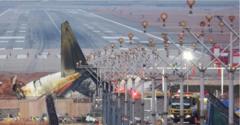The Jeju Air flight reportedly crash-landed at Muan International Airport after a bird strike led the pilot to abort the landing approach. Consequently, the aircraft came down without deploying landing gear, skidding along the runway before colliding with a concrete structure positioned about 250 meters from its end. This collision caused the aircraft to burst into flames, leading to significant loss of life.
Air safety specialist David Learmount stated that the plane's collision with the wall was a critical factor in the high death toll, asserting that if the obstruction hadn't been there, survival rates could have been substantially higher. This structure, which serves as a localiser for navigation, was designed to be at runway level but has come under scrutiny for its rigid construction that did not give way upon impact.
Christian Beckert, a Lufthansa pilot, echoed the concerns, noting that typically, end-of-runway structures are made to be frangible (easily breakable) to mitigate risk during accidents. There are fears that the wall's unyielding design may have contributed significantly to the outcome of this crash.
As investigations continue, South Korea's transportation ministry promises to assess whether such structures should be redesigned using more breakable materials. Chris Kingswood, another pilot with extensive experience, suggested that airport safety standards would be evaluated to ascertain compliance, hinting that similar structures may exist at other airports without due consideration for obstructions.
Moreover, the need for clarity on whether the pilots were aware of such a barrier remains crucial. Aviation analyst Sally Gethin emphasized that understanding the pilots' knowledge of the localiser's presence would be key to the investigation, especially since the flight's approach differed from the standard procedure.
As the inquiry seeks answers, families of the victims and the aviation community await further details on the investigation, bringing to light the urgent need to reassess safety protocols surrounding airport structures.
Air safety specialist David Learmount stated that the plane's collision with the wall was a critical factor in the high death toll, asserting that if the obstruction hadn't been there, survival rates could have been substantially higher. This structure, which serves as a localiser for navigation, was designed to be at runway level but has come under scrutiny for its rigid construction that did not give way upon impact.
Christian Beckert, a Lufthansa pilot, echoed the concerns, noting that typically, end-of-runway structures are made to be frangible (easily breakable) to mitigate risk during accidents. There are fears that the wall's unyielding design may have contributed significantly to the outcome of this crash.
As investigations continue, South Korea's transportation ministry promises to assess whether such structures should be redesigned using more breakable materials. Chris Kingswood, another pilot with extensive experience, suggested that airport safety standards would be evaluated to ascertain compliance, hinting that similar structures may exist at other airports without due consideration for obstructions.
Moreover, the need for clarity on whether the pilots were aware of such a barrier remains crucial. Aviation analyst Sally Gethin emphasized that understanding the pilots' knowledge of the localiser's presence would be key to the investigation, especially since the flight's approach differed from the standard procedure.
As the inquiry seeks answers, families of the victims and the aviation community await further details on the investigation, bringing to light the urgent need to reassess safety protocols surrounding airport structures.




















